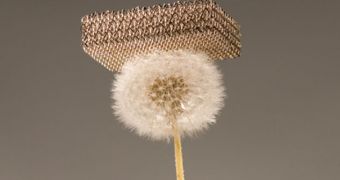A group of experts at the California Institute of Technology (Caltech) announces the development of the lightest solid material ever developed. An entire brick made out of the material weighs nearly nothing, the team says.
The work was conducted under the supervision of assistant professor of materials science and mechanics Julia Greer, who holds appointments with the HRL Laboratories, LLC and the University of California in Irvine (UCI).
According to the team behind the work, the material has a density of just 0.9 milligrams per cubic centimeter. Its extremely-low weight makes it especially suitable for applications such as protective shielding and battery electrodes, among many others.
However, its reduced density does not make the material weak. In fact, it is apparently incredibly strong, and also capable of absorbing a large amount of energy. This further increases the potential array of uses experts can put it to.
The construct, Greer reports, is called a micro-lattice, and is made up of 99.99 percent open air, and 1 percent nickel-phosphorous tubes. The latter are hollow on the inside, and intersect with each other at various nodes, created recurring, asterisk-like units in the open space.
This material is “a lattice of interconnected hollow tubes with a wall thickness of 100 nanometers, 1,000 times thinner than a human hair,” explains HRL Labs research scientist Tobias Schaedler, who was also the lead author of a paper detailing the findings.
“The emergence of the unique properties of these ultra-light micro-lattice structures is due, in part, to the different mechanical behavior that emerges in nano-sized solids, which is the focus of my research,” Greer goes on to say.
The micro-lattice is capable of compressing by as much as 50 percent when subjected to an impact, for example, but it does not break. Its resiliency comes from the hierarchical structure of the tiny tubes that make up its solid component.
Details of the new study appear in a paper called “Ultralight Metallic Lattices,” which was published in the November 18 issue of the top journal Science. Funds for the research were provided by the US Defense Advanced Research Projects Agency (DARPA).

 14 DAY TRIAL //
14 DAY TRIAL //